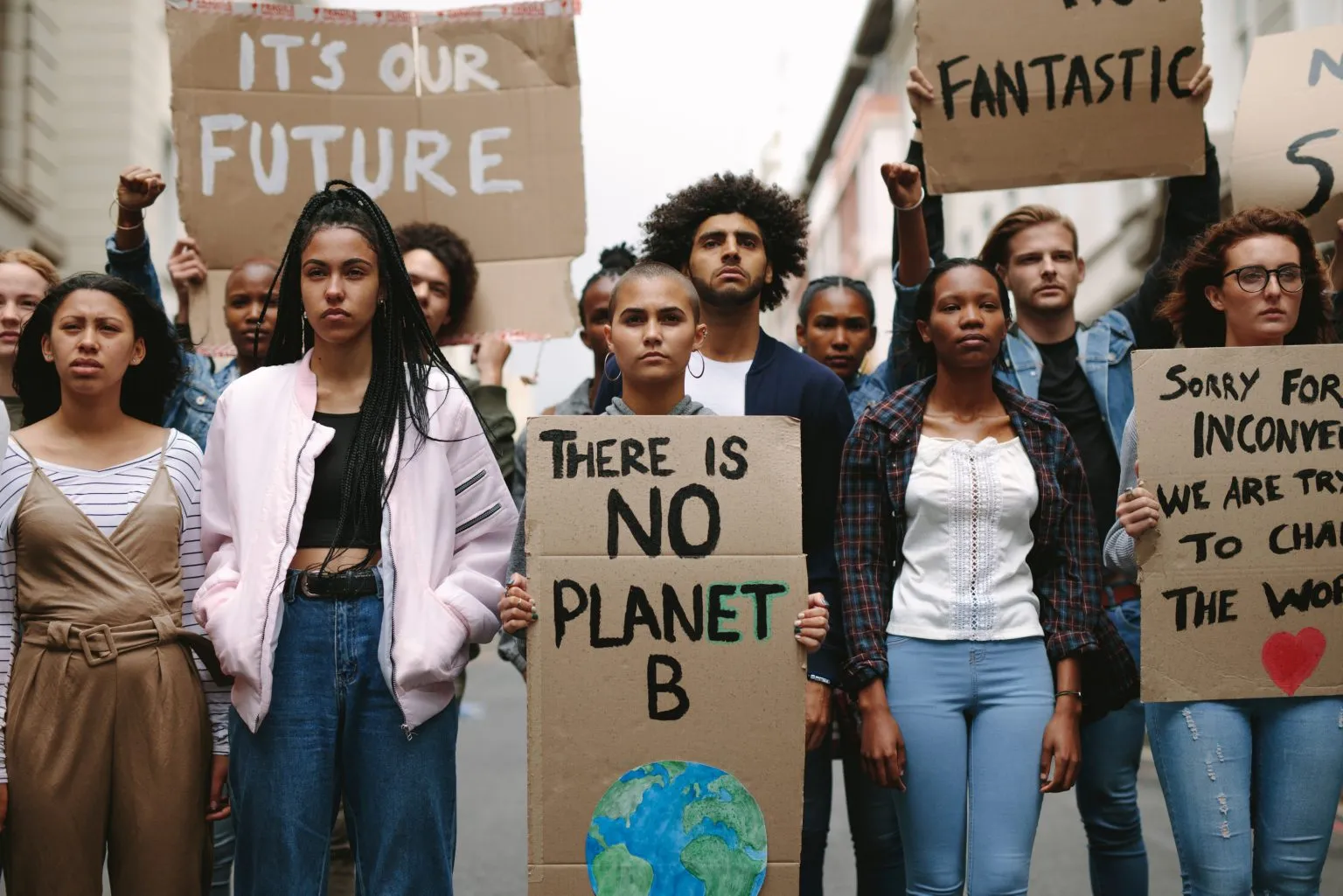-
CENTRES
Progammes & Centres
Location
Youth capital can become an essential driving force of sustainable development and climate change movement.

The global impact of climate change has only worsened over the years. Scorching temperatures in India, prolonged droughts in Northern Kenya and torrential rains in Bangladesh are just a few instances of the adverse effects of the climate crisis, impacting the lives of millions across different regions of the world. This has brought to the forefront the dual imperatives of a green transition while advancing social justice and highlighted the importance of “just transition” as a robust framework that seeks to reconcile these interlinked goals. The concept of a “just transition” for a climate-resilient future resonates globally. International organisations and countries worldwide are increasingly prioritising a multi-pronged approach that delivers sustainable green growth for all. However, for the Global South, “just transition” is not merely an option but its only chance at a sustainable future. To enable a green transition that meets its development aspirations, the Global South must recognise its’ existing strengths and reorganise its priorities. An inspiring force in this regard is the youth of the Global South—uniquely positioned to catalyse transformative changes in energy, innovation, and communities that secure an inclusive and equitable future. Cultivating and leveraging the human capital embodied in its young population, the developing and emerging nations of the world can galvanise a positive change toward youth-led “just transition”.
For the Global South, “just transition” is not merely an option but its only chance at a sustainable future.
The International Labour Organization (ILO) defines “just transition” as “greening the economy in a way that is as fair and inclusive as possible to everyone concerned, creating decent work opportunities and leaving no one behind.” Embodying a holistic approach to environmental sustainability, social equity, and economic resilience, this framework advocates deliberate green practices while ensuring that the accompanying social and economic changes are fair, inclusive, and empower the most vulnerable. In its pursuit of green transition pathways, the Global South is confronted with a distinct and complex set of challenges. The Global South, owing to its geography and political economy, remains the most vulnerable to the impacts of climate change. This has led countries in the Global South to proactively advocate for the “just transition” framework in its efforts to advance decarbonisation, green growth, green capacity-building and climate resilience. Transitioning towards green growth requires that the developing world has adequate access to resources, equal opportunity, alternative livelihood frameworks and financing. The Global South also has a significant fraction of its population working in sectors and related activities, which will be negatively affected by the green transition, thus jeopardising their income and livelihood. The existence of socio-economic inequalities, the inadequacy of resources for implementing welfare programmes, and the lack of access to technology, especially green technology, leave the Global South at a disadvantage compared to the countries of the Global North.
The Global South, owing to its geography and political economy, remains the most vulnerable to the impacts of climate change. This has led countries in the Global South to proactively advocate for the “just transition” framework in its efforts to advance decarbonisation, green growth, green capacity-building and climate resilience.
In its report, the United Nations Intergovernmental Panel on Climate Change (UNIPCC) noted that Asia and Africa will witness a tremendous increase in their urban population by 2050. About 1 billion people, primarily from the most marginalised communities in developing countries, will live in low-lying cities and settlements and be at risk from coastal flooding. While climate change does not discriminate between both worlds, economies of the Global North are more resource-rich and, therefore, better equipped to deal with these challenges. For the Global South, on the other hand, the limited resources remain to be delicately balanced between the need to enable energy transition and climate change mitigation pathways and the climate adaptation and overall development needs of its population. Therefore, only through a “just transition” can the differential impacts of the climate crisis be mitigated, preventing the Global South from coming out worse off from a global transition to green growth.
As the last generation of individuals who can slow down global warming to prevent any further worsening of climate impacts, the youth population in the developing world has become a significant stakeholder in this regard. Across Asia, Africa, Latin America and the Caribbeans, the lives of close to 1 billion young people will continue to be impacted by climate change-induced food insecurity. Besides its direct impact, climate change is also impacting the long-term productivity of these young individuals. Studies show that nearly 60 percent of a surveyed youth population report suffering from climate anxiety, while 45 percent among them also observe productivity loss. The average level of climate anxiety among the youth in the Global South is higher than in the Global North (see figure 1). Even in a successful green transition scenario by 2030, nearly 77 percent of the global youth population in the developing world will be competing for an estimated 18 million green jobs created as a result of the transition, demanding a transformed workforce and new skill sets.
Figure 1: Levels of youth’s climate anxiety across countries
Source: Statista
Approximately 1.8 billion people worldwide are between 15 to 29 years old. The youth in the Global South covers about 90 percent of the world’s total youth population today. Asia and Africa alone are home to the most significant number of young people in the world—by 2040, 28 percent of the African population and a massive 52 percent of the Asian population will be comprised of young people. This indicates that the youth population is the most prominent stakeholder and agent of change to enable the “just transition” pathways across the Global South countries. Embodying a massive demographic dividend in the form of significantly high productive and learning capabilities, the young people in these parts of the world can lead the global combat against climate change.
Youth capital can become an essential driving force of sustainable development and climate change movement.
In a Global Youth Consultation Dialogue on Energy, organised by the United Nations Development Programme (UNDP) in 2021, 315 energy enthusiasts under 30 came up with recommendations to address the climate change and energy transition emergency. They emphasised the role of youth in fuelling the energy transition process. Youth capital can become an essential driving force of sustainable development and climate change movement. Empowering youth capital focuses on encouraging and promoting the participation of young people in decision-making processes and innovation to foster more resilient communities. The preparation of the second generation of Nationally Determined Contributions (NDCs) also emphasised consultations with youth groups and their inclusion in relevant solutions. Youth participation has been on the rise in many countries. They are involved in several educational and awareness-raising initiatives, including youth NGOs such as YOUNGO, the Climate Change Challenge Network developed by the United Nations Global Alliance and the Youth Climate Action Lab in India.
To lead a “just transition” in the Global South, young people, with their out-of-the-box thinking, can devise innovative solutions to address environmental challenges, create sustainable technologies, develop climate-resilient agriculture methods, or implement community-based renewable energy projects. This can enable the implementation of localised, context-specific solutions. The youth of the Global South can also leverage the increased digital penetration more efficiently and mobilise these tools to enhance climate change advocacy and governance across interest groups. Young people are often more open to interdisciplinary collaboration and peer-to-peer learning solutions, bridging fields such as science, technology, art, and social sciences. This cross-pollination of ideas can lead to holistic and integrated approaches to just transitions, considering environmental, social, and economic dimensions. With its aptitude for taking up new skills, the youth is also well-placed to take up green jobs that contribute toward the preservation and restoration of the environment, be it in traditional sectors such as manufacturing and construction or in new, emerging green sectors such as renewables, is crucial.
However, these advancements grapple with systemic disparities limiting youth participation in the Global South. To realise their full potential as agents of transformation, it is critical to successfully cultivate the human capital in this young population through adequate investments in health, education, and skilling. In addition, horizontal policy coordination to foster the role of youth in climate change governance across various departments and intergenerational partnerships that accord adequate importance to the pivotal role of youth in driving global climate action and provide them with a suitable platform is of utmost importance. To conclude, as a “just transition” places the whole society at the centre of a net-zero future, maximising the opportunities and minimising the challenges, youth participation in policy-making, awareness campaigns, and decision-making remains a crucial influence. With the Global South comprising most of the world’s young population, it is only rational to leverage this youth capital to create a sustainable future. It is, therefore, high time that society, at large, recognises the power of youth and the importance of investing in this youth’s future.
Debosmita Sarkar is a Junior Fellow at the Observer Research Foundation.
Ashi Pandey is a Research Intern at the Observer Research Foundation.
The views expressed above belong to the author(s). ORF research and analyses now available on Telegram! Click here to access our curated content — blogs, longforms and interviews.

Debosmita Sarkar was an Associate Fellow with the SDGs and Inclusive Growth programme at the Centre for New Economic Diplomacy at Observer Research Foundation, India. Her ...
Read More +